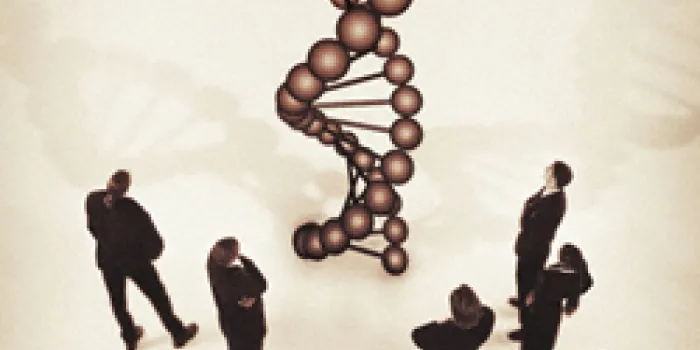Read more about the research discussed at the workshop.
Scientific literature and terms such as “viral vectors” and “tissue factor pathway inhibitor” can be intimidating, even to people with bleeding disorders and their families. Not so for three consumers selected to attend the National Hemophilia Foundation’s (NHF’s) 10th Workshop on Novel Technologies and Gene Transfer for Hemophilia at the University of North Carolina at Chapel Hill February 5–6, 2010. Two of them are working on PhDs in science fields, and one is a medical student.
“Having a science background definitely helped,” says Brian Psciuk, whose 2-year-old son, Landon, has severe hemophilia A. “I’m used to reading scientific literature.” Psciuk is midway through his PhD program in physical chemistry at Wayne State University in Detroit.
The other PhD student is Brent Winslow of Salt Lake City, who has mild von Willebrand disease and is finishing his PhD in bioengineering. The third panelist, Matthew Wofford, is a first-year medical student at the University of North Carolina (UNC) at Chapel Hill and has severe hemophilia A.
The biennial conference brings together the world’s hemophilia experts to share and discuss breakthroughs in bleeding and clotting disorders research and technology. The three consumers attended sessions throughout the two-day conference, capping off the workshop with a panel discussion for the audience of researchers and clinicians.
Wide Range of Research
The three men listened to scientists discuss their latest research in areas such as longer-lasting and faster-acting recombinant factor products, bypassing agents that allow people with inhibitors to receive treatment, and oral treatments that would replace infusions.
“I was impressed with the breadth of the topics discussed,” Wofford says. “That, along with the fact many of these approaches have been demonstrated effective in animal models, made me very optimistic that some of these novel treatments will be working their way into trials and, hopefully, clinics before too much longer.”
The panelists are interested in the potential of gene therapy replacing defective genes—such as those that cause hemophilia—with healthy ones. Several studies are attempting to find the most effective way to insert genes into the body, whether through stem cell transplantation, viral vectors (using a noninfective virus to transport healthy genes into the body) or some other method. (To learn more about gene therapy, visit Hemophilia Gene Therapy Breakthroughs.)
“I have a lot of hope for gene therapy,” Winslow says. “It has huge potential not just for bleeding disorders, but for many other disorders. I could envision gene therapy as a cure for hemophilia.”
Psciuk was intrigued by the idea of developing a virus to infiltrate cells with healthy genes. “I hadn’t been exposed to viral vectors in the past. Getting some of the details on this research was fascinating—that they’re actually able to do gene therapy in this way.”
Sharing Their Stories
During the consumer panel at the end of the conference, the panelists shared their stories about living with bleeding disorders and answered audience questions. Psciuk says researchers didn’t need to be reminded that their scientific work could someday help people with bleeding disorders. “It was very apparent that everybody there was extremely concerned, not just about their research, but about the people this affects,” he says. “Never once did I feel that everybody was treating this too objectively. There was a genuine feeling of concern for patients and their families.”
Wofford stressed the importance of safety in medicine and protecting the blood supply. He’s sensitive to the issues after contracting hepatitis C as a child through a contaminated transfusion. Following six months of interferon and ribavirin therapy during his senior year of high school, Wofford, now 22, has been clear of hepatitis for five years.
“What happened back in the ’80s with contaminated blood products was a real tragedy,” Wofford says. “Nobody wants something like that to get repeated. I got the sense that the researchers are really being cognizant of safety as they work to develop new treatments.” He was reassured when one of the researchers told him that scientists should always ask themselves, “Is this therapy something I’d be willing to try on my own son?”
Looking Ahead
The three panelists are still considering where their science careers may take them. Winslow, the soon-to-be bioengineer, hasn’t decided whether to take a position in industry or academia. Among other things, bioengineers create medical devices, he explains. “Nearly everything in the hospital passes through the hands of a bioengineer at some point.”
Wofford has three more years of medical school, then residency. He hasn’t decided on an area of medicine yet either, although many people have asked him, “Are you going to be a hematologist?”
Psciuk, the physical chemistry PhD student, is investigating whether he can use his area of expertise in a hemophilia research project. “A lot of it has to do with the different sizes of the systems. Dealing with the human body and large proteins is a very large system; sometimes I will look at systems with only five atoms, something very tiny in comparison.”
Psciuk will also be learning more about hemophilia on the home front. His son was diagnosed with hemophilia two days after he was born, with no family history. “Because my son is so young, I’m still very much wet behind the ears as far as hemophilia.” The conference allowed Psciuk to ask the bleeding disorders community about ports, infusions, prophylaxis and insurance. “I can’t say enough about the workshop. It was truly an amazing experience.”

